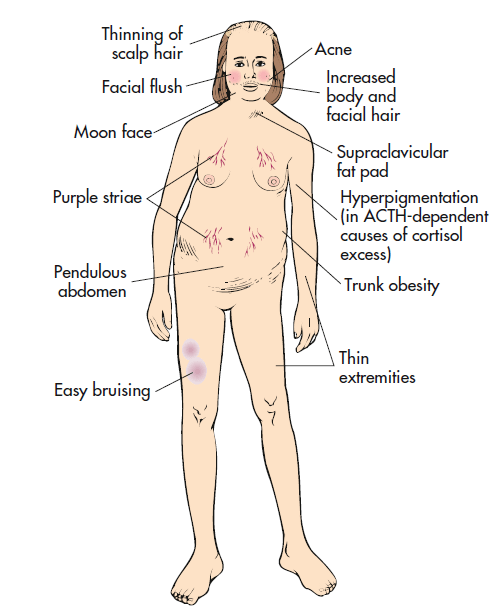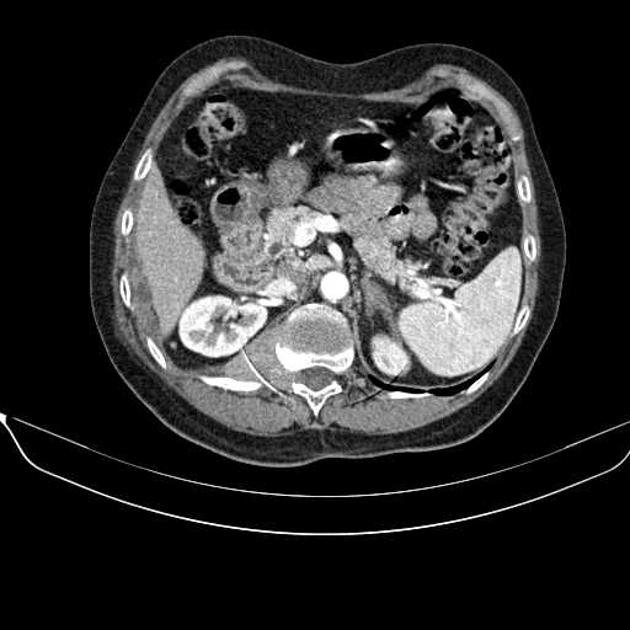Cushing's Syndrome
content of this page
1- Introduction
2- Physiological Overview
3- Symptoms
4- Treatment
Introduction

Physiological Overview
Cortisol, a hormone produced by the adrenal glands, plays a crucial role in regulating metabolism, immune response, and stress levels. However, excessive cortisol, whether due to overproduction by the adrenal glands (often caused by tumors) or prolonged use of corticosteroid medications, leads to a cascade of physiological effects.
Physiologically, Cushing’s syndrome manifests in various ways. One hallmark is the redistribution of body fat, resulting in a characteristic round face (“moon face”) and increased fat deposits around the abdomen and upper back (“buffalo hump”). This fat redistribution is coupled with muscle wasting, especially in the limbs, contributing to weakness and difficulty in performing daily activities.
The skin undergoes notable changes, becoming thin and fragile, with a propensity for bruising easily. Stretch marks, known as striae, may develop on the abdomen, thighs, and breasts due to the loss of skin elasticity. Moreover, individuals with Cushing’s syndrome often experience increased susceptibility to infections and delayed wound healing due to the immunosuppressive effects of cortisol.
Metabolically, Cushing’s syndrome can lead to glucose intolerance and eventually diabetes mellitus as cortisol interferes with insulin function and promotes gluconeogenesis (the production of glucose from non-carbohydrate sources). This metabolic disturbance is often accompanied by hypertension (high blood pressure), which further increases cardiovascular risk.
In addition to these physical manifestations, individuals with Cushing’s syndrome may suffer from psychological symptoms such as irritability, anxiety, and depression, reflecting the profound impact of cortisol on brain function and emotional regulation.

Symptoms
Weight Gain and Fat Redistribution: One of the most noticeable symptoms is weight gain, particularly in the face (creating a round or “moon” face), abdomen, and upper back (resulting in a “buffalo hump”). This occurs due to increased deposition of fat in these areas while muscles may become weakened and wasted.
Skin Changes: Skin manifestations include thinning, easy bruising, and the development of purple or pink stretch marks (striae) on the abdomen, thighs, breasts, and arms. The skin may also become more susceptible to infections and slow to heal.
Metabolic Disturbances: Individuals with Cushing’s syndrome often develop glucose intolerance, leading to diabetes mellitus in some cases. This results from cortisol’s interference with insulin function and promotion of glucose production by the liver (gluconeogenesis).
Cardiovascular Issues: Hypertension (high blood pressure) is common in Cushing’s syndrome and increases the risk of cardiovascular diseases such as heart attacks and strokes.
Musculoskeletal Problems: Muscle weakness, particularly in the limbs, can occur due to the breakdown of muscle protein and impaired muscle function caused by excess cortisol.
Emotional and Psychological Changes: Mood swings, irritability, anxiety, and depression are frequently reported. These symptoms may be related to cortisol’s effects on the brain and its impact on emotional regulation.
Menstrual Irregularities and Fertility Issues: Women with Cushing’s syndrome may experience menstrual irregularities, such as amenorrhea (absence of menstruation), and fertility problems due to disruptions in hormone levels.
Other Symptoms: Additional symptoms can include fatigue, decreased libido, bone thinning (osteoporosis), and increased susceptibility to infections.
Treatment
Surgical Intervention: If Cushing’s syndrome is caused by a tumor (such as an adrenal adenoma or pituitary adenoma), surgical removal of the tumor is often the first-line treatment. This can be done through adrenal gland surgery (adrenalectomy) or transsphenoidal surgery for pituitary tumors.
Medication: If surgery is not an option or if the tumor cannot be completely removed, medications may be used to suppress cortisol production or block its effects:
- Corticosteroid synthesis inhibitors: Drugs like ketoconazole, metyrapone, and mitotane can block the enzymes involved in cortisol production.
- Corticosteroid receptor blockers: Medications like mifepristone can block cortisol from binding to its receptors, reducing its effects.
Radiation Therapy: For pituitary adenomas that cannot be completely removed surgically, radiation therapy may be used to shrink or control the tumor.
Bilateral Adrenalectomy: In cases where other treatments fail or are not feasible, removing both adrenal glands may be considered as a last resort. However, this approach requires lifelong hormone replacement therapy.
Lifestyle Changes: Managing lifestyle factors such as diet, exercise, and stress can help improve overall health and may support other treatments.
Monitoring and Follow-up: Regular monitoring of cortisol levels and symptoms is crucial, as well as managing any complications or side effects from treatments.